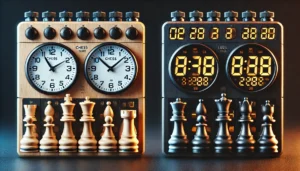Introduction
Using a chess clock can elevate your game, adding a layer of strategy and urgency that enhances the experience. Whether you’re a novice or a seasoned player, understanding how to use a chess clock effectively is essential. This guide will walk you through the types of chess clocks, basic time control methods, and provide practical tips for managing your clock during a game.
Key Takeaways
- Different types of chess clocks include analog and digital.
- Basic time control methods range from classical to blitz.
- Effective clock management can significantly impact your game performance.
Outlines
- Types of Chess Clocks
- Analog Clocks
- Digital Clocks
- Basic Time Control Methods
- Classical
- Rapid
- Blitz
- Increment and Delay
- Clock Management Tips
- Time Allocation
- Decision-Making Under Pressure
- Practicing with a Clock
Types of Chess Clocks
1. Analog Clocks

Analog clocks are the traditional type of chess clocks. They feature two adjacent clock faces, each with a button that stops one clock and starts the other. These clocks are durable and have a classic feel, often favored in formal and traditional settings. However, they lack some of the advanced features found in digital clocks, such as increment and delay settings.
2. Digital Clocks

Digital clocks are modern and come with various features that make them versatile for different types of games. They can be programmed for different time controls, including increment and delay. Digital clocks typically display the remaining time more precisely and are easier to read at a glance. They are widely used in both casual and professional settings due to their functionality and accuracy.
Basic Time Control Methods

Understanding the different time control methods is crucial for optimizing your chess strategy. Each method requires a different approach to time management, affecting how you play the game.
1. Classical
Classical time control is typically used in formal tournaments and competitive play. Each player gets a significant amount of time, often ranging from 60 minutes to several hours. This allows for deep strategic thinking and complex planning. Players must balance their time across the entire game, ensuring they have enough time to navigate the endgame effectively.
2. Rapid
Rapid chess is faster-paced, with each player usually getting between 10 and 60 minutes. This format requires players to think quickly while still making strategic decisions. It’s a popular choice for players who enjoy a faster game but still want enough time to develop a thorough game plan.
3. Blitz
Blitz chess is extremely fast, with each player typically having 3 to 5 minutes for the entire game. This format tests a player’s quick thinking and reflexes. There’s little room for deep contemplation, so players must rely on intuition and experience. Blitz is exciting and often leads to dynamic, unpredictable games.
4. Increment and Delay
Increment and delay are features available on digital clocks. They add an extra layer of complexity to time management:
- Increment: With each move, a small amount of time (usually a few seconds) is added to the player’s clock. This ensures that even if a player is running low on time, they can accumulate enough seconds per move to avoid losing on time.
- Delay: A delay period is a fixed amount of time that counts down before the player’s main time starts. If a player makes a move within this delay, their main time doesn’t decrease.
Both increment and delay can reduce the pressure of losing on time, allowing for more thoughtful moves even in faster-paced games.
Clock Management Tips
Effective clock management can be the difference between winning and losing. Here are some tips to help you manage your time better during a game.
1. Time Allocation

Allocate your time wisely throughout the game. Spend more time in critical positions and less time on straightforward moves. In the opening, rely on your preparation and use less time. Save your time for the middle game and endgame, where the positions are more complex and require deeper calculation. This strategic allocation ensures you have enough time to think when the game reaches its most crucial stages.
2. Decision-Making Under Pressure
Learn to make decisions quickly under pressure. Practice playing with a clock regularly to improve your ability to think fast. During the game, if you find yourself in time trouble, prioritize making safe and solid moves rather than looking for the best move. This reduces the risk of making blunders. Developing a habit of quick decision-making can significantly enhance your performance, especially in faster time controls like blitz.
3. Practicing with a Clock
Incorporate the use of a chess clock into your regular practice sessions. This helps you become comfortable with the ticking clock and improves your time management skills. Play games with different time controls to adapt to various pacing and pressure situations. By practicing with a clock, you also learn to manage the psychological pressure that comes with time constraints, preparing you better for actual competitions.
Conclusion
Mastering the use of a chess clock not only sharpens your time management skills but also adds a strategic depth to your game. By familiarizing yourself with the types of clocks, understanding various time control methods, and applying effective clock management techniques, you can enhance your overall chess-playing experience.
Whether you are playing a leisurely classical game or an intense blitz match, using a chess clock effectively can elevate your game to new heights. Practice these tips, and watch your chess skills grow!
